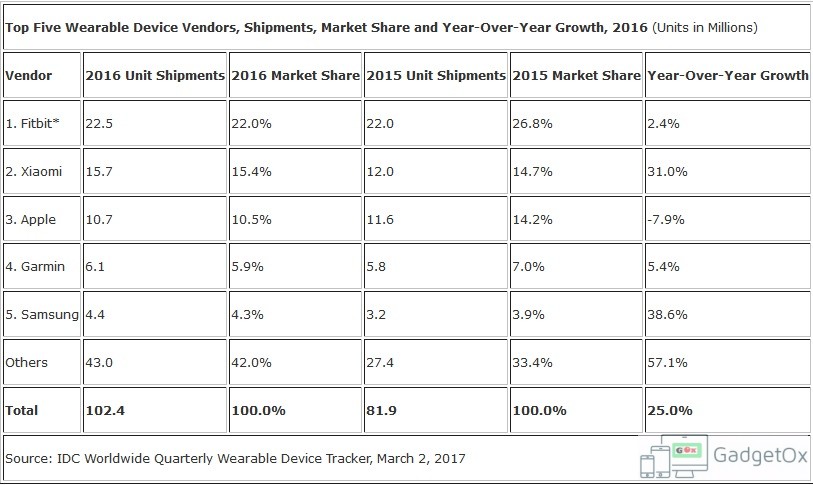
IDC has released its Wearable devices report for the Q4 2016 and the full year 2016. All-time high shipments reached 33.9 million units in the fourth quarter of 2016 (4Q16), growing 16.9% year over year. Shipments for the entire year 2016 grew 25%.
Key takeaways from the report are listed below.
- Wearable devices shipment increased to 102.4 million in 2016 from 81.9 million in 2015
- Fitbit remains the leading vendor worldwide with 22% market share
- Apple has ceded market share in 2016. It sold 10.7 million Apple watches in 2016 as compared to 11.6 million in 2015.
- Xiaomi and Samsung are gainers with increasing their market share YOY. Xiaomi in fact has nearly doubled its shipments in Q4 2016.

Here are more details about five top wearable vendors,
Fitbit maintained its dominance, holding the top position for both the quarter and the year. However, the company also faced one of its largest declines ever as it remained heavily focused on the U.S., a market that is quickly approaching saturation for fitness trackers. Though the company has grown in other parts of the world, it also remained challenged as low-cost competitors eat away at Fitbit’s market share.
Xiaomi’s relentless growth helped to close the gap between it and the top vendor. Like its other product lines, the company has stuck with a low-cost strategy and has slowly tried to veer upstream in terms of pricing by introducing new devices with heart rate monitoring and a mildly higher selling price. However, Xiaomi still lacks the expertise and brand recognition to expand beyond its native borders in China.
Apple Watch Series 1 and Series 2 proved to be a magnificent success for the company as it was the company’s best quarter ever in the wearables market. The lower entry price point and the inclusion of GPS on the Series 2 along with a completely revamped user interface have helped the company grow its presence. Apple is one of the few companies that has been able to quickly refocus its watch to gain traction in the consumer market and has also been leading the charge on introducing the smartwatch category to the commercial segment.
Garmin experienced a slight decline of 4.0% in 4Q16. However, the company did manage to significantly raise its average selling price (ASP) to $258 in the fourth quarter from under $200 last year. Garmin caters to a more dedicated fitness audience and this has worked well as many of its users began to graduate from simpler fitness trackers to more sophisticated and expensive sport watches like those offered in the Fenix line. The new Fenix 5 announced at CES 2017 also shows promise as the new smaller size will help the device appeal to a broader audience.
Samsung rounded out the top 5 with the launch of two new models (Gear S3 Classic and Frontier) and remains the only major company offering cellular-enabled wearables. LTE connectivity has been a key differentiator for Samsung’s watches as it has helped decouple them from smartphones, but more importantly it has opened up a new channel (telcos) to help promote the Samsung watches. Outside of watches, Samsung’s portfolio also includes the Gear Fit 2 and the Icon X, though without any smartphone bundles, volumes for these wearables were lower than expected.
